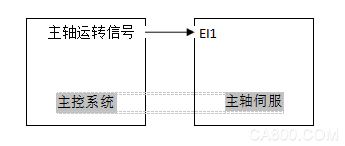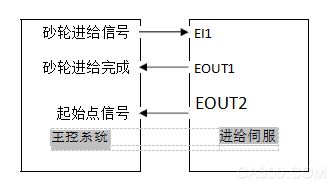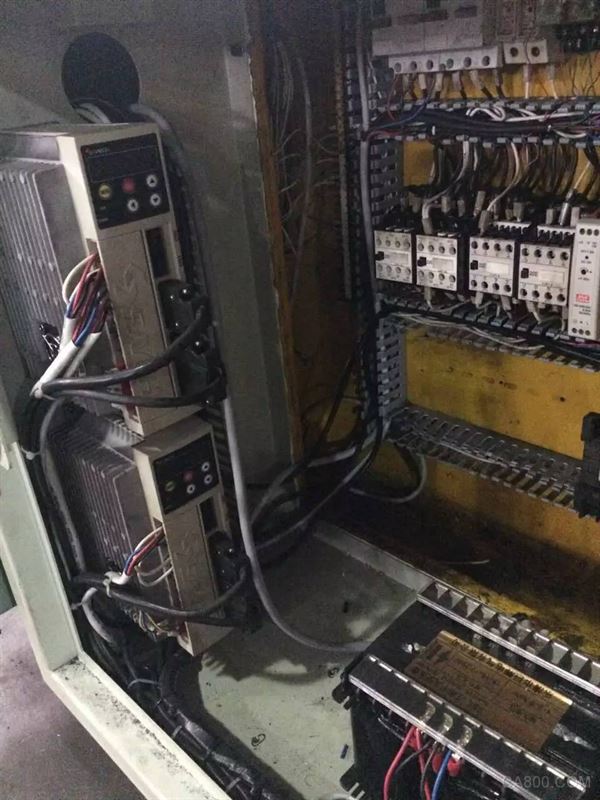**Overview (Background):**
This grinder is primarily designed to grind specific sections of automotive components to a precise diameter, ensuring stable and reliable performance while maintaining high machining accuracy. The grinder features two servos—one for spindle positioning and another for grinding wheel feed. Previously, the CNC system acted as the primary controller, with PLC and servos handling spindle positioning and sending pulses to the grinding wheel feed servo to execute grinding tasks. However, in this updated scheme, the CNC system remains the central controller, but the servos handle the core functions. This approach reduces the need for a PLC, simplifies wiring, and enhances control efficiency.
**Process Requirements:**
1. **Spindle Positioning:** During machining, the spindle rotates the workpiece after gripping it. Once machining is complete and the spindle stops, the position might not align consistently due to inertia. This inconsistency can lead to workpieces getting stuck in the fixture, disrupting subsequent operations. Previously, the customer used a combination of PLC and servo for spindle positioning, resulting in a costly and complex system. To address this, the customer adopted specialized servos, allowing the spindle to stop at a fixed position after operation. This improves the ease of clamping and removing workpieces.
2. **Grinding Wheel Feeding:** While grinding, the grinding wheel moves from high speed to low speed and gradually approaches the target position for machining. After the process is completed, it returns to its starting point. Initially, the control system sent pulses for this operation, dividing it into three stages and making the process intricate. Following customer feedback, the solution was modified to use specialized servos, enabling automatic movement at specified speeds over defined distances.
**Program Details:**
1. **Spindle Positioning:** When the run signal is inactive, the servo locks. When the run signal is active, the servo operates at a constant rotational speed. Upon receiving an off signal, the servo calculates the required compensation based on the mechanical transmission ratio, travels to the positioning point, and then locks again.
2. **Grinding Wheel Feeding:** When the feed signal is inactive, the servo locks. When the main control system outputs the feed signal, the servo adjusts its speed automatically according to the stroke, divided into three segments. After reaching the designated position, it sends a corresponding signal back to the main control system. When the feed signal becomes inactive, the servo returns to the starting point at a preset speed, locks after completing the movement, and sends a signal to the main control system.
**Advantages of the Program:**
1. **Traditional Method Disadvantages:**
- **Spindle Positioning:** Required a PLC and custom programming, increasing costs and complexity.
- **Grinding Wheel Feed:** Complicated programming led to reduced stability and lower precision.
2. **Program Advantages:**
- **Spindle Positioning:** Replacing [PLC + Common Servo] with a dedicated servo simplifies usage and reduces costs.
- **Grinding Wheel Feed:** The system is streamlined, allowing simple instructions to dictate precise actions. Control is straightforward, and accuracy is enhanced.
**Implementation of the Program:**
1. **Wiring Schematic (System Block Diagram):**



In summary, this upgrade significantly enhances the efficiency and reliability of the grinder, offering a cost-effective and simplified solution for both spindle positioning and grinding wheel feeding.
PVC-Polyvinyl Chloride
PVC (Polyvinyl Chloride) is a widely used thermoplastic polymer that finds extensive applications in the manufacturing of cables due to its cost-effectiveness and various desirable properties. Here's an overview of PVC as a cable material:
### Properties of PVC Cable Material:
1. **Durability**: PVC cables are resistant to wear and tear, making them suitable for both indoor and outdoor use.
2. **Flame Retardancy**: PVC has good flame retardant properties, which means it does not easily catch fire and will self-extinguish once removed from a source of ignition.
3. **Chemical Resistance**: PVC is resistant to many chemicals, oils, and acids, providing protection against environmental damage.
4. **Flexibility**: Depending on the formulation, PVC can be made flexible or rigid, making it suitable for various applications.
5. **Cost-Effective**: PVC is relatively inexpensive compared to other cable insulation materials like TPE (Thermoplastic Elastomers) or XLPE (Cross-linked Polyethylene).
6. **Environmental Concerns**: While PVC is durable and versatile, it is not biodegradable and its production involves the use of chlorine, which can lead to environmental concerns if not properly managed.
### Applications:
- **Domestic Wiring**: PVC-insulated wires are commonly used in residential wiring due to their safety and durability.
- **Telecommunications Cables**: PVC is often used in telecommunications cables for its flexibility and resistance to moisture.
- **Automotive Wiring**: Due to its flexibility and chemical resistance, PVC is used in automotive wiring harnesses.
- **Industrial Applications**: PVC cables are also used in industrial settings where they need to withstand harsh conditions.
economical,PVC Cable Material,Flame Retardancy,Ease of Installation,plastic-insulated,PVC as a cable material
ZHONG HAN INTERNATIONAL TRADE CO., LTD , https://www.cck-ht.com